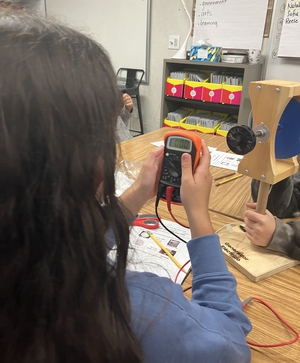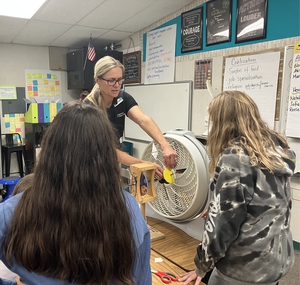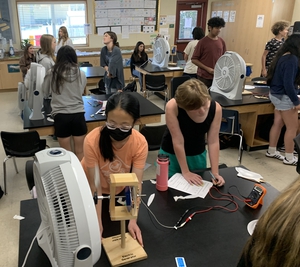6th-8th Grade: Electricity and Climate Change
Wind Energy Challenge
Available to schools located in:
Sonoma and Mendocino counties
Lesson Summary:
This lesson explores the connection between the electricity we rely on every day and Earth's rapidly changing climate. Students learn about the nonrenewable and renewable forms of energy used to generate electricity in California and the state's progress toward its goal of transitioning to 100% renewable energy by 2045. Students work in small groups on a hands-on STEM challenge to generate electricity with wind and a small turbine.
Teachers can choose between two 50-minute classroom visits or one 90-minute block to complete the lesson.
STEM Wind Challenge:
Teams work together to generate electricity by designing and creating wind blades capable of spinning a small generator.
Objectives:
- Students become aware of the connection between electricity generation and global warming.
- Students become aware of the need to move to renewable energies as sources of electricity generation.
- Students work in groups to complete a STEM challenge.
- Students reflect on the design and engineering process.
Next Generation Science Standards:
Earth and Human Activity: MS-ESS3-5 One solution to human-caused climate change is transitioning from generating electricity with fossil fuels to renewable energy.
Engineering Design: MS-ETS1-2, MS-ETS1-3 Students design, construct, and test a wind blade fitted on a small wind turbine to generate at least 2.5V of electricity with a box fan.
Scientific and Engineering Practices:
- Asking questions: What can we create that will cause the wind turbine to spin as fast as possible?
- Defining problems: Why is our wind blade not working or what can we do to improve it to generate more electricity?
- Mathematics and computational thinking: Students record voltage for 5 trials and measure blade angle with a protractor.
Crosscutting Concepts: cause and effect, structure and function, stability and change, systems and system models
Water and Energy Education programs are FREE thanks to funding from these partners:







